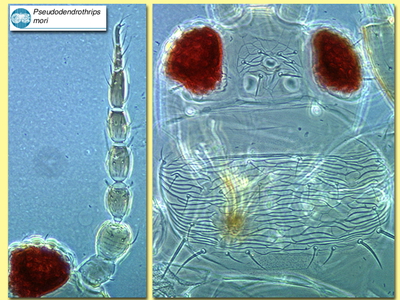Figures
Fig. 1 Antenna and head (dorsal)
Fig. 2 Antenna, head, thorax, fore and hind wings
Fig. 3 Hind tarsus, tergite IV and V
Species
Pseudodendrothrips mori Niwa
Biology
A widespread pest of the leaves of Morus, particularly on silk-worm farms. This minute species jumps actively when disturbed.
Distribution
China and Japan, and presumably other S.E.Asian countries; also USA (Illinois) and Queensland, Australia.
Recognition
Very small thrips with white body and legs, distal antennal segments lightly shaded brown, forewings pale but very weakly shaded. Head wider than long, with 3 pairs of ocellar setae, pair III between anterior margins of posterior ocelli. Antennae 8- or 9-segmented, VII variably divided medially, VII-IX as long as VI; III & IV with sense cone forked; VI with a long sense cone arising near base on inner margin. Pronotum with many transverse lines, 2 pairs of posteroangular setae. Metanotum with median lines of sculpture converging, median pair of setae not at anterior margin; metasternal endofurca elongate 'lyre-shaped' extending to mesothorax. Forewing first vein with about 7 widely spaced setae, second vein without setae; posteromarginal cilia not wavy. Tarsi 1-segmented, hind tarsus more than two-thirds as long as hind tibia. Abdominal tergites II-VIII with median pair of setae much longer than distance between their bases, laterally with about 10 transverse lines of sculpture each bearing many short linear ridges; VIII with well developed posteromarginal comb of microtrichia; IX with many microtrichia dorsally.
Related species
Sixteen species are recognised in this genus, all of which have the hind tarsi more than half as long as the hind tibiae, and the abdominal tergites laterally with short linear ridges on the transverse lines of sculpture. P. bhattii, which is widespread on Morus leaves in S.E. Asia, is the most closely related species, and has possibly been confused with P. mori in published records. However, P. bhattii has shaded forewings and small brown linear markings on the pronotum.




